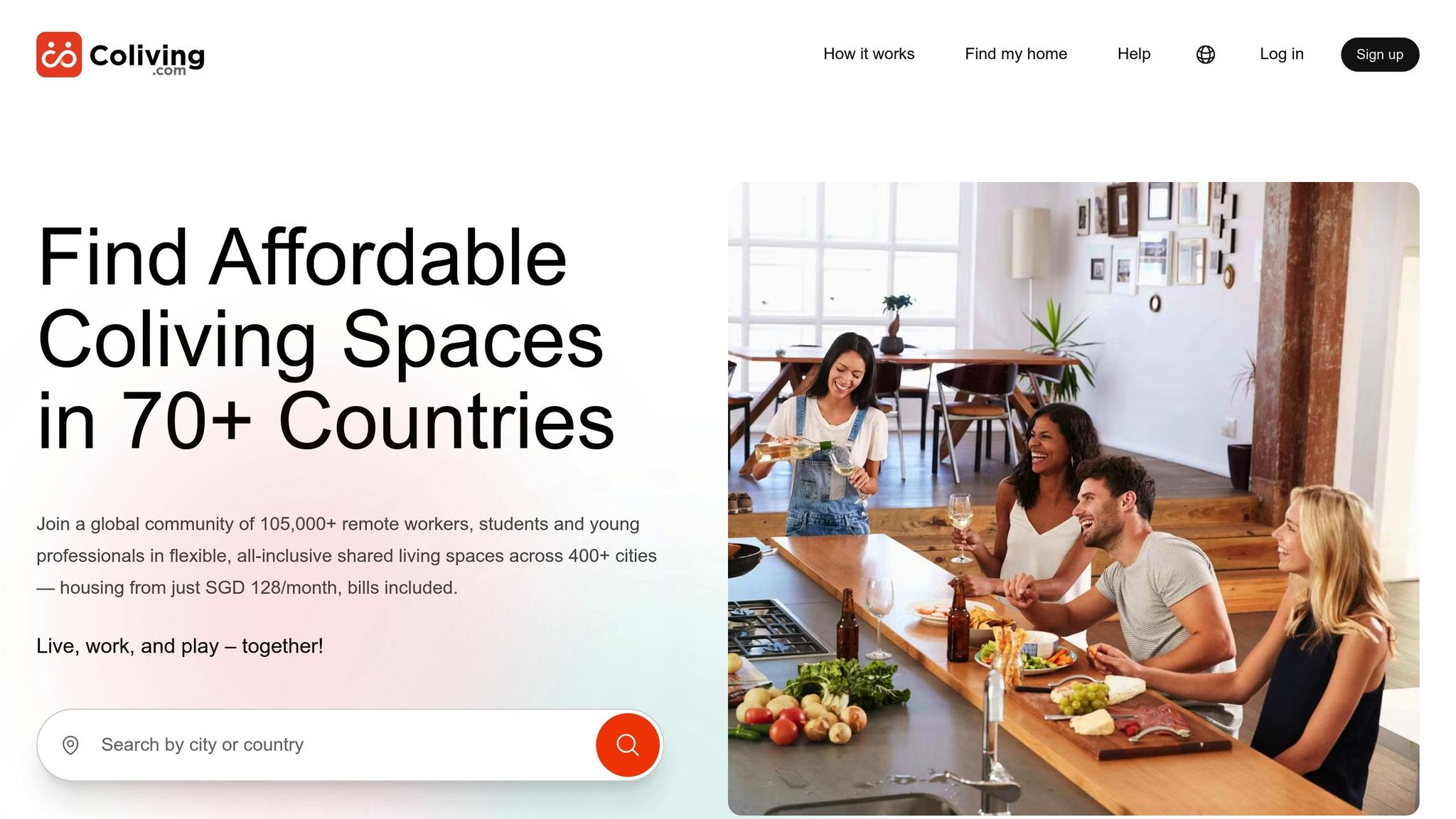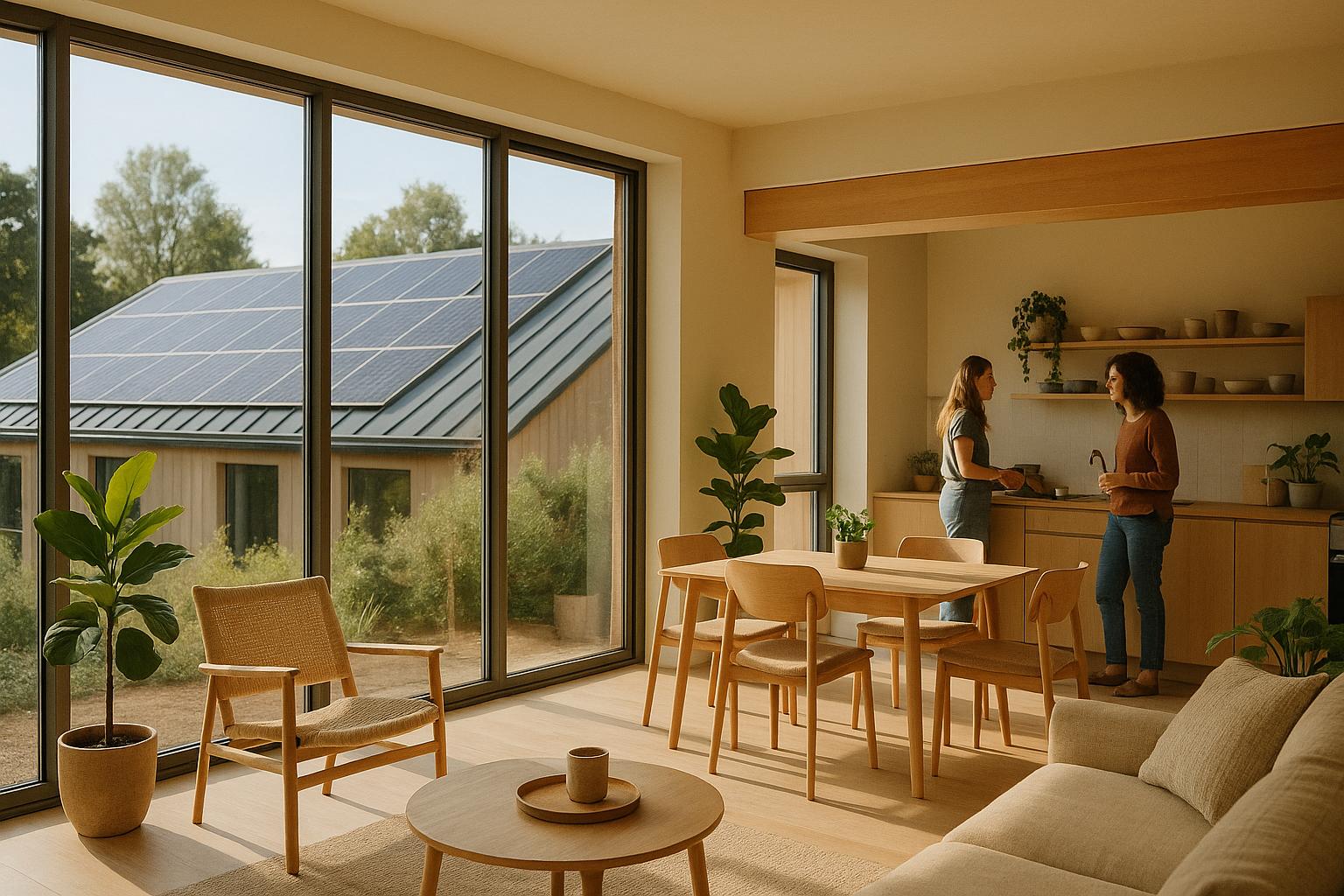Want to turn your coliving space into a vibrant community? Here’s how:
- Design Spaces for Connection: Combine shared areas (kitchens, lounges) with private spaces to balance interaction and personal downtime.
- Streamline Communication: Use tools like Slack for updates, host regular meetings, and offer anonymous feedback options.
- Celebrate Diversity: Respect different communication styles, use translation tools if needed, and schedule events that accommodate varied schedules.
- Host Engaging Activities: Plan regular events (workshops, dinners) and let residents organize their own gatherings to encourage participation.
- Optimize Common Areas: Make shared spaces functional and inviting with flexible seating, good lighting, and accessible layouts.
- Use Platforms Like Coliving.com: Simplify logistics with all-inclusive services, flexible rental options, and tools for hosts to manage communities effectively.
Building a connected coliving space isn’t just about shared housing - it’s about creating an environment where people connect, collaborate, and thrive.
Building Blocks of a Strong Coliving Community
Creating a successful coliving community starts with thoughtful design that encourages meaningful connections among residents.
Finding the Right Mix of Shared and Private Areas
Striking the perfect balance between communal spaces and private retreats is key. Coliving environments often feature shared areas like kitchens, living rooms, workspaces, and recreational zones, which foster interaction and collaboration. At the same time, private spaces provide residents with a place to unwind and stick to their personal routines. Transitional spots, such as cozy reading nooks, cater to both socializing and solitude, offering flexibility based on individual preferences. The goal is to design spaces that seamlessly support daily life while accommodating a variety of needs.
How Smart Design Brings People Together
The layout of a space can shape how people interact. Thoughtfully designed coliving spaces encourage organic connections. For instance, shared pathways that guide residents through common areas - like kitchens or central courtyards - naturally create opportunities for casual encounters. Acoustic treatments and clear zoning ensure that lively communal spaces coexist with quieter areas for work or relaxation. Open sightlines, often referred to as "friendly surveillance", allow residents to feel part of a larger community even when they’re engaged in their own activities.
These design principles set the stage for fostering strong communication among residents, a topic explored further in the next section.
How to Improve Communication Between Residents
Strong communication is the backbone of any successful coliving community. When residents can openly share their needs, discuss concerns, and connect with ease, it reduces misunderstandings and fosters meaningful relationships. The trick is to create systems that make communication simple, respectful, and inclusive for everyone.
Setting Up Clear Communication Systems
One of the best ways to streamline communication in coliving spaces is by using digital platforms. Tools like Slack can help organize conversations into dedicated channels for announcements, maintenance updates, event planning, and casual chats. This keeps everything in one place and ensures important messages don’t slip through the cracks.
Regular house meetings are another essential piece of the puzzle. Hosting face-to-face meetings, either monthly or bi-weekly, allows residents to address updates, events, and concerns directly. Stick to a clear agenda and consider rotating facilitators to encourage shared responsibility and prevent any one person from dominating the discussion.
For those who may feel uncomfortable speaking up in group settings, anonymous feedback systems can be a game-changer. Simple solutions like Google Forms or suggestion boxes in common areas let residents voice their thoughts privately. Make it a habit to review this feedback regularly and address the key points during house meetings.
To help new residents settle in, include clear communication guidelines and contact details in their welcome packets. This ensures they quickly understand how to stay connected and participate in the community.
Once these systems are in place, it’s equally important to acknowledge the diversity of backgrounds and communication styles within the group.
Respecting Different Backgrounds and Customs
In communities with residents from varied cultural backgrounds, understanding and respecting different communication styles is crucial. Some people may prefer direct communication, while others might lean toward a more indirect approach. Establishing ground rules that accommodate these differences helps create an inclusive environment.
Language barriers can pose challenges, but they’re manageable with thoughtful solutions. Translation apps can help during group discussions, and written summaries in multiple languages can ensure everyone stays informed. Residents who share a common language can also step in to assist newcomers, fostering mentorship and a sense of belonging.
For communities with remote workers or international residents, time zone awareness is key. Avoid scheduling important discussions at times when certain residents are consistently unavailable. For non-urgent matters, consider using asynchronous communication tools like shared documents or message boards to gather input from everyone.
Another way to build understanding is through cultural celebration and education. Informal sessions where residents share their communication preferences, customs, or holiday traditions can go a long way in preventing misunderstandings. These conversations also encourage deeper connections among residents.
With these practices in place, a community manager can play a central role in ensuring everything runs smoothly.
How a Community Manager Helps
A community manager is often the glue that holds resident communication together. They act as a central point for conflict resolution, onboarding, and event coordination, while also keeping communication channels organized and effective.
Onboarding support is one of their key responsibilities. A community manager can help new residents settle in by hosting orientation sessions, introducing them to others, and checking in regularly during the first few weeks to address any challenges they might face.
When it comes to event coordination, community managers handle logistics like tracking RSVPs, sending reminders, and gathering feedback. They ensure events cater to a variety of interests and help bring the community closer together. Additionally, they moderate online discussions and keep digital platforms running smoothly.
Investing in strong communication systems and a proactive community manager can lead to lower resident turnover, fewer conflicts, and a happier, more connected community. These efforts lay the groundwork for vibrant activities and events that make coliving spaces feel like home.
Planning Activities That Bring Residents Together
After establishing clear communication systems, the next step to building a connected community is organizing activities that bring people together. Hosting a variety of events - like social gatherings, workshops, or wellness sessions - can cater to different interests and create a lively, interactive environment. These activities naturally complement effective communication practices, making the community more cohesive.
Setting Up Regular Community Events
Creating a regular schedule of events helps establish a rhythm and gives residents something to look forward to. Whether it’s a casual meet-and-greet or a workshop that showcases the talents of community members, consistent planning encourages involvement. Over time, these events can become part of residents' routines, making community engagement feel natural and effortless.
Letting Residents Organize Their Own Activities
Giving residents the freedom to plan their own events is a great way to reflect the community's diverse interests. By offering simple tools or platforms for residents to propose and lead activities, you empower them to take an active role. This collaborative approach not only increases participation but also nurtures a sense of ownership and belonging among residents.
Using Shared Calendars to Keep Everyone Informed
Keeping everyone in the loop about upcoming events is crucial. A shared digital calendar is an easy and effective way to ensure all residents are aware of the schedule. This tool makes it simple for everyone to stay updated, allowing them to participate in activities that fit their personal schedules while fostering a sense of inclusivity.
Setting Up Common Areas That Bring People Together
The way a physical space is designed can significantly influence how people interact within a community. A well-thought-out environment supports the social connections that tie residents together. When common areas are designed with care, they encourage people to naturally come together, turning a collection of private living spaces into a lively and connected community. These shared spaces become the heart of coliving, fostering interactions and creating a sense of belonging.
Making Shared Areas Welcoming and Useful
The success of a shared space often hinges on striking the right balance between comfort and practicality. For example, a kitchen should serve more than just its functional purpose - it should be a social hub. Adding a large island or a peninsula can create a space where residents can prepare meals together while chatting, blending utility with connection.
Lighting also plays a big role in setting the mood. Swap out harsh fluorescent lights for softer, layered options like table lamps, floor lamps, or string lights to create a warm, inviting atmosphere that encourages people to stay and interact.
Flexible seating arrangements can make a big difference, too. Sofas, movable chairs, ottomans, and floor cushions can be rearranged easily to suit different needs - whether it’s a quiet one-on-one conversation, a group discussion, or even solo work.
To keep these spaces inviting, organization is key. Built-in shelving and smart storage solutions can help keep clutter at bay, ensuring common areas remain neat and welcoming for everyone.
Making Sure Spaces Work for Everyone
Just as communication should cater to diverse needs, common areas should be designed with inclusivity in mind. Accessibility ensures that all residents can comfortably use these spaces.
Wide doorways and open pathways make it easier for those using mobility aids to navigate. Furniture arrangements should allow for easy movement, and important features like kitchen counters and storage should be accessible at various heights. In shared workspaces, adjustable-height desks can accommodate both seated and standing preferences, making the space versatile for everyone.
Inclusivity goes beyond physical design. Spaces should reflect the diverse lifestyles and customs of residents. For instance, kitchens can include multiple sinks, separate prep areas, and ample refrigerator space to accommodate different cooking practices and dietary needs. Quiet zones within common areas can offer a retreat for those who prefer calm, while livelier sections cater to more social residents.
Sensory needs are another important consideration. Some residents may be sensitive to loud noises, bright lights, or strong smells. Using sound-absorbing materials like rugs, curtains, and upholstered furniture can help reduce noise levels. Dimmable lighting options and good ventilation in cooking areas can also make the environment more comfortable for everyone.
Keeping Shared Spaces Comfortable Year-Round
Comfort is a key factor in how often residents use shared spaces, and temperature control plays a major role. Keeping common areas between 68°F and 72°F ensures they remain pleasant throughout the year.
Zone-based climate control can make shared spaces even more adaptable. For instance, kitchens might need cooler temperatures due to heat from appliances, while areas like reading nooks might benefit from being slightly warmer for added coziness. Programmable thermostats can help maintain these ideal conditions by adjusting temperatures based on daily usage patterns.
Natural light is another important element, but it comes with challenges. Large windows can bring in warmth during the summer and cold drafts during the winter. Energy-efficient window treatments like thermal curtains or cellular shades can help regulate these temperature swings without sacrificing natural light. Ceiling fans are another simple yet effective addition, improving air circulation and making spaces feel cooler without lowering the thermostat.
Seasonal adjustments can also enhance comfort. In summer, swap out heavy blankets and warm lighting for lighter fabrics and brighter illumination. Outdoor common areas, like patios or rooftop spaces, can be equipped with features like retractable awnings, outdoor heaters, or enclosed gazebos to make them usable in a variety of weather conditions.
Finally, regular HVAC maintenance - like changing filters monthly and scheduling seasonal tune-ups - helps keep shared spaces comfortable and the air fresh all year long.
Using Coliving.com's Features to Build Community

Once you've laid the groundwork with thoughtful design and effective communication, Coliving.com's platform takes it a step further by simplifying how communities come together. By breaking down common barriers to connection, the platform makes it easier for residents to engage with one another. Let’s dive into how its all-inclusive services, flexible rental options, and management tools contribute to creating vibrant, connected communities.
Simplifying Life with All-Inclusive Services
Imagine moving into a new place and not having to worry about setting up utilities, hunting for reliable Wi-Fi, or figuring out a cleaning schedule. That’s the reality with Coliving.com’s all-inclusive services. By bundling essentials like utilities, internet, and cleaning, the platform eliminates common stressors and potential sources of conflict. Everyone gets equal access to these services, creating a fair and hassle-free living environment.
For remote workers and digital nomads, this setup is a game-changer. Instead of wasting time on tedious logistics, they can dive straight into building connections and settling into the community. And with a money-back guarantee, new residents feel more confident about their decision, making them more likely to engage in group activities and invest emotionally in their new home.
Flexible Rental Options That Welcome Everyone
Diverse communities thrive when people from all walks of life can easily join. Coliving.com’s flexible rental terms make this possible, accommodating a variety of needs and lifestyles. Whether it’s students on short-term exchanges, professionals on temporary assignments, or long-term residents looking for stability, everyone can find a place that fits their timeline.
Short-term residents bring fresh energy and new perspectives, while long-term residents often provide the stability and leadership that help newcomers feel at home. With spaces available in 380 cities across 70+ countries, the platform fosters a global network of connections. Residents can meet others who’ve lived in similar places or gain advice about future destinations.
The easy cancellation policies also make joining a coliving community less intimidating. Knowing they can adjust their plans if needed encourages more people to take the leap. And with prices starting at just $100 per month, these spaces become accessible to students, early-career professionals, and others who might otherwise find community living out of reach. This affordability invites a mix of residents, enriching the community with diverse perspectives and experiences.
Tools That Empower Hosts to Build Better Communities
At the heart of every thriving coliving space is a host who knows how to bring people together. Coliving.com equips hosts with tools that streamline logistics, so they can focus on fostering connections. The fully digital process takes care of everything from inquiries to move-ins, giving hosts more time to engage with residents and plan meaningful activities.
Features like online rental agreements cut down on administrative work, allowing hosts to respond quickly to residents’ needs. With access to ,900 coliving spaces, hosts can also share tips and strategies with one another, learning best practices for everything from welcome events to conflict resolution.
With 750 active hosts managing communities, there’s a wealth of knowledge on how to create spaces where people naturally connect. When logistical tasks are simplified, hosts can focus on what really matters - introducing residents with shared interests, organizing group activities, and fostering a sense of belonging.
The platform also helps hosts maintain clear communication, track engagement, and identify ways to improve the living experience. By giving hosts the tools to understand their communities better, Coliving.com ensures they can make adjustments that keep residents happy and connected. Ultimately, these tools help hosts strengthen the bonds that make coliving communities feel like home.
Conclusion: Creating a Connected Coliving Community
Creating a thriving coliving community goes far beyond sharing a roof - it’s about nurturing an atmosphere where real, meaningful connections can flourish. The best coliving spaces strike a balance between thoughtful design and intentional efforts to bring people together, ensuring residents feel both at home and part of something bigger.
A well-thought-out mix of private spaces for relaxation and inviting common areas naturally encourages interaction. This design fosters easy communication and active participation. Tools like digital platforms, regular meetings, or even a dedicated community manager help address issues quickly while strengthening bonds among residents. Simple yet effective gestures - like weekly dinners, skill-sharing workshops, or shared calendars for organizing events - can go a long way in building a sense of belonging. Over time, consistent and varied activities help form deeper, lasting relationships.
When paired with Coliving.com’s tailored features, the process becomes even smoother. All-inclusive services remove common pain points, and flexible rental terms attract a diverse group of residents, each bringing unique perspectives and energy to the community. With access to 1,900 coliving spaces and 750 hosts, there’s a wealth of experience to draw from to fine-tune your approach.
Keep in mind that building a community is never a one-and-done effort. The most successful coliving spaces evolve by listening to residents and adapting to their needs. By combining smart design, clear communication, and engaging activities, you create a space that grows alongside its residents. When authentic connections take center stage, you build a community that people truly value - and are reluctant to leave.
FAQs
How can I create a good balance between shared and private spaces in a coliving community?
Creating the right mix of shared and private spaces in a coliving environment takes careful planning. Shared areas like open kitchens, inviting lounges, or versatile multi-use rooms should be designed to bring people together and build a sense of community. At the same time, it’s equally important to provide private, soundproof rooms where residents can unwind and enjoy some solitude.
Features like adaptable layouts, clear distinctions between communal and private zones, and a natural flow between spaces can make all the difference. This balance helps residents connect socially while also having the opportunity to recharge in peace, creating a comfortable and inclusive living experience for everyone.
What are the best ways to improve communication and handle conflicts in a diverse coliving community?
To strengthen communication and address conflicts in a diverse coliving community, start by establishing clear expectations and boundaries that everyone can agree on. Encourage open, respectful conversations and prompt residents to address misunderstandings early - this helps prevent small issues from growing into bigger problems.
Highlighting shared values and goals can bridge differences and promote mutual understanding among residents. Create a straightforward process for resolving conflicts and stress the importance of shared responsibility in maintaining a peaceful and welcoming environment. These steps lay the groundwork for a connected community where everyone feels valued and heard.
How can I use Coliving.com to build a strong community and simplify managing my coliving space?
Coliving.com provides the tools you need to build a vibrant and connected community. With features like messaging systems, event planning tools, and forums, residents have plenty of opportunities to interact and collaborate. These tools are designed to create a stronger sense of belonging and make your coliving space feel more engaging.
On the management side, Coliving.com takes the hassle out of daily operations. Automated rent collection, bill tracking, and smart access systems simplify administrative tasks. This means you can spend less time on logistics and more time fostering a welcoming atmosphere. These features not only make managing your space easier but also improve the overall living experience for everyone involved.






